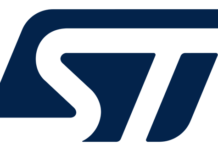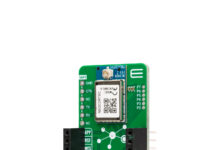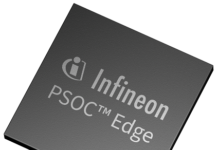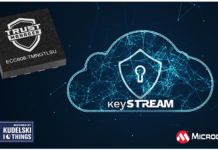
Unmanned, automated car parks, smart homes that can understand you and buildings that can sense temperature… Over the past decade, the Internet of Things (IoT) has seen incredible growth with these new connected devices, enabling a large amount of data to be harnessed in real time, generating an unprecedented level of insight. The Internet of Things has seen extensive development over the past decade to the point that there are now very few sectors that have not embraced it.
As this reach increases, so does the need for greater intelligence, especially as more complex technology and applications are seeking to utilise the IoT. There are other areas under scrutiny too, with the requirement for low power consumption, reliability, ease of use and security also in demand. It is these factors that IoT manufacturers must consider to truly optimise products working in the field and to ensure they are addressing the challenges of users. How to effectively implement innovative IoT technologies and applications and how to produce ‘killer’ IoT solutions are among the key questions on many engineers’ minds.
The Explosive Growth of IoT Connections
The Internet of Things is covering increasingly wide areas and bringing significant value to the electronics industry, with new significant innovations coming every year. The number of IoT devices has exploded in the past decade, covering a wide range of industries, from medical devices, home appliances, consumer electronics, to building and industrial automation. Wearable devices, sensors, appliances and medical monitors are all connected and able to collect and share a large amount of data. Now 5G, cloud computing, artificial intelligence and other enabling technologies are further accelerating the process of IoT.
This growth across the Internet of Things is happening all around us. Looking at home applications, for example, smart energy meters allow for remote meter reading, saving considerable labour and time. In the application of the Industrial Internet of Things (IIoT), we can also see that more factories are collecting data from a greater number of devices. By creating a larger network of devices, companies can have a clearer insight into their processes, allowing for quicker and more intelligent decision making. Regardless of whether we are talking about IoT for home or industrial applications, the ability to reduce costs and effort, as well as providing valuable insight, are some of the major driving factors behind IoT’s incredible growth.
From IoT to Intelligent IoT: Key Technical Challenges and Barriers
The concept of ‘Internet of Things’ was first proposed by Professor Kevin Ashton of the Massachusetts Institute of Technology. His idea was based on technologies such as RFID (Radio Frequency Identification) and web code to construct a physical internet that achieves real-time sharing of information for all global items based on the internet. Nowadays, with the development of technology and evolution of applications, the connotation of the Internet of Things has undergone some changes. As an extension of the Internet in both depth and coverage, the Internet of Things can achieve information exchange and interconnection between all people and all things.
At present, the Internet of Things refers to the deployment of various sensing devices with certain perception, computing, and execution capabilities in the physical world. Backed by network facilities, information transmission, collaboration and processing. These factors combine to produce the information interconnection and exchange between people and devices. We can summarise the key themes of the Internet of Things as ‘perception, transmission, and processing’.
At the perception layer, it is necessary to acquire various streams of information from the physical world through multiple capturing approaches, such as sensors, radio frequency identification (RFID), QR codes and multimedia data collection. This perception through sensors is the very core of many IoT applications.
At the transmission level, wireless connectivity is a crucial technology. With deployed networks playing the critical role of getting the physical and digital worlds seamlessly converged. Through the widespread wireless connectivity technology, it is possible to connect everything to the internet. This type of hyper connection has many advantages. It can enable automated control, allow for easy communication between devices and for the sharing of information. In turn, the collection and analysis of large datasets enables intelligent decision making.
As the number of connected devices increases, the amount of information generated also increases. Processing and analysing these datasets allows us to generate higher value insights, supporting true digital management and operation. As more and more data is collected, we can update the applications and technologies continuously. We can even take this automation further by introducing artificial intelligence (AI) to perform analysis and forecasting. This type of approach will lead to a future where many tasks that were previously managed by humans could be handled automatically and intelligently.
With the increasing number of connected devices, machines are becoming more intelligent. But as the applications are becoming increasingly more diverse, the entire industry has to face some additional problems and challenges, ranging from design solutions to practical real-world applications.
Challenge 1: Fragmentation of IoT Applications and Technical Standards
The fragmentation of IoT applications has haunted manufacturers for a long time. With an increasing number of connected devices and application scenarios becoming more diverse, the challenge of fragmentation is only growing.
There is no single technical standard that can cover all IoT application scenarios. In fact, within specific areas of industrial and home applications, you will face many different technical standards. This leads to the coexistence of multiple protocols to meet the numerous requirements, which inevitably increases the complexity of widespread deployment and the cost of equipment and maintenance.
Finding a solution to this issue is quite the challenge, but many experts believe the answer to the fragmentation problem ultimately relies on the market itself. When one technology stands out and can cover more applications than others, the market will gradually shift towards this solution. Already, the wireless communication standards around us are constantly evolving, showing that likely the market will address the fragmentation itself over time.
Wireless protocols are one of the primary concerns for the development of the Internet of Things. The current mainstream protocols include Wi-Fi, Bluetooth, Zigbee, Matter, and Thread. While currently, many of these wireless connection protocol standards have existed in isolation. It has become a focus of efforts of the IoT industry in recent years on how to achieve interoperability for IoT devices using different protocols.
Matter, released in October 2022, is one of the latest standards and represents an exciting innovation. By being built on the top of existing IP connection protocols, and can achieve simple IoT communication across different platforms, including end products, mobile applications and cloud services.
Silicon Labs, a leading wireless electronics manufacturer, has created a Matter wireless solution for volume production and passed the certification of CSA Connectivity Standards Alliance. This solution can be used to develop Matter products supporting Thread, Wi-Fi and Bluetooth protocols. By providing unified connectivity standards for various smart home and commercial applications such as LED bulbs, door locks, HVAC, commercial lighting and access control modules, Matter can simplify product development and improve the experience for end users.
Prior to this, Silicon Labs implemented multi-protocol solutions to address diversified application scenarios by a single chip. In 2015, Silicon Labs launched the industry’s first multi-protocol IoT chip, the wireless Gecko EFR32xG series. Now, in its third generation, the chip can support multiple protocols such as Zigbee, Bluetooth, Wi SUN and Z-Wave. Allowing users wanting to design a product that is suitable for different environments to use this chip to deal with a range of scenarios, simplifying the design process.
Challenge 2: Low Power Consumption is the Key to the Success or Failure of IoT Solutions
As IoT deployments increase to cover low power and battery-based devices, system power consumption becomes a more prominent issue. To allow IoT uptake in these devices, manufacturers of wireless IoT products have focused heavily on their system efficiency. With low power consumption now a standard feature in many IoT solutions, it has been a key innovation in the successful uptake of IoT within many new applications.
This reduction in power consumption has been fuelled by two major factors. The first is the hardware, which is mainly the power consumption of the chip itself. Over the past few decades, the semiconductor industry has developed from 90nm, 40nm, 28nm, and then 14nm, with integration continuously improving. At the same time, developments in software and wireless protocols have helped to reduce the power requirement. The power consumption brought by IoT data transmission is in close relation to the frequency of transmissions and the amount of data transferred, so improvements in either can directly increase system efficiency.
In addition, the power consumption is not only related to chips and standard protocols but also to the relevant specifications of passive components, such as Bluetooth antennas for example. In recent years, the efficiency of Bluetooth has increased, further reducing power consumption.
Challenge 3: Electromagnetic interference
Electromagnetic interference (EMI) is another major challenge for engineers. With the increasing number of IoT devices and more varied deployments, some frequency bands become incredibly congested. This leads to mutual interference between modules, placing a heightened importance on reliable filtering and anti-interference measures.
For example, how do engineers overcome co-channel interference in urban applications? From a design perspective, electromagnetic interference occurs because several antennas from different devices are too close together, allowing for them to generate crosstalk. Multiple methods can be used to solve electromagnetic interference problems in the industry. From the perspective of passive components, we can use some methods to control the external radiation of RF signals and to shield components from interference.
Due to the complicated application scenarios of various IoT solutions, the diverse requirements and design specifications, it is difficult to have a single solution that can solve all problems. Currently, we are reliant on engineers continuously debugging and solving the problem in terms of the specific requirements of different devices. In the long run, to effectively solve EMI problems, a comprehensive effort from multiple parties is required, including a set of unified and strict IoT solution design specifications.
Digging Deep into Vertical Applications: The Unlimited Market Potential for Smart Cities, Smart Healthcare and Smart Homes
As the wide penetration and deep rooting of IoT technology happens across various industries, it may lead to the ‘next industrial revolution’, which will profoundly change all aspects of people’s life, such as work, travel and entertainment. It may even change the way businesses or organisations interact globally. Nowadays, the Internet of Things has been in rapid development with very broad market prospects, covering many vertical application fields such as wearable devices, smart homes, smart cities, logistics management, intelligent manufacturing and smart agriculture.
The Internet of Things is happening around us. For example, in smart city applications, smart meters which are network enabled can conduct remote readings, saving considerable labour and time costs. In the application of the Industrial Internet of Things, we can see that many factories are connecting equipment to networks to share the data acquired. Providing the insight needed for further optimising production lines and improving efficiency.
Trending Vertical Application 1: Smart City
By using a variety of information technologies or innovative concepts, a smart city can connect and integrate various stems and services together to improve the efficiency of resource utilisation, optimise urban management and services, as well as enhancing the quality of life of citizens. A more harmonious and convenient urban life could materialise in a smart city this way.
There are many applications involved in a modern city, such as power distribution facilities, meter facilities, rooftop solar panels and streetlight management, as well as intelligent building, vehicle and road system management. Digital management is a crucial aspect in enabling cities to apply the ‘intelligence’. But the prerequisite for achieving digital management is that considerable aspects of the city should essentially become IoT devices. Capable of collecting various types of data in real-time, as well as transferring this information to the cloud for further analysis, optimising city management and improving overall efficiency.
There are many barriers facing the design of smart city schemes. First, the scalability factor and deployment size are a considerable issue. Maintaining thousands of devices working together with long-distance communication in harsh environments is an incredible challenge.
Second, the complexity we must face because of the coexistence of multiple standards, as well as other issues like wiring and battery power supply. There are many application scenarios in smart cities, which will inevitably adopt different communication methods. For example, cameras which require high bandwidth will be reliant on 5G for transmission, whereas some low bandwidth devices may use NB IoT. In addition, there are some new application trends, such as adding Bluetooth to the electricity metering, which again furthers the number of communication systems in use.
The third challenge is compatibility, which requires all the devices to support both traditional and future technical standards. When the life cycle of deployed smart city solutions often lasts for 5-20 years, their reliability, futureproofing and safety are crucial. For example, as smart meters have become widespread in cities, we are reliant on them for residential electricity monitoring, smart gas meters for natural gas usage and monitoring, as well as other energy or heat meters.
If we look at just smart meters, a solution has to be robust, durable for decades and able to accurately transmit and use data throughout its entire lifecycle. For design engineers to meet this challenge, many components must be miniaturised while ensuring their durability, as well as leaving additional capacity for future functionality. The wireless transmission of smart meters also needs to overcome EMI and may require customised antennas to adapt to different application environments. Outdoor wireless connections often encounter even more challenges, including various potential EMI sources and signal blocking issues.
Trending Vertical Application 2: Smart Health
The COVID-19 pandemic has dramatically increased public attention to health issues. But what can the Internet of Things do for smart medical or healthcare?
Many medical and health devices have become increasingly intelligent, featuring IoT characteristics like portability, miniaturisation and comprehensive networking. From pulse ECG monitors to fitness wearable devices that can continuously monitor and track patients’ physiological conditions, collected health data can now be remotely viewed on a smartphone via simple Bluetooth connection.
This utilisation of data can be taken further than merely showing current conditions. With many systems analysing the information to provide an early preview of our own health trends. This ability to harness and analyse large volumes of data can also help to develop preventive healthcare measures. As more data is accumulated and analysed, it is more likely that we can prevent and improve the treatment of a condition in advance, rather than intervention after symptoms appear.
Some technical challenges are present in IoT-based medical and healthcare, including the improvement of sensor accuracy and the development of algorithms. But it is now possible to use machine learning and other means to train the algorithms through large datasets within a Cloud environment. Then, once the algorithms have been honed, deploy them locally to run in a low-power and low-cost way. At the same time, these algorithms can be continually developed, and as the volume of data increases and time passes, they should become increasingly accurate. By continually updating these algorithms, medical devices will gain greater insight and accuracy as time increases.
Given the general trend of ageing populations, the analysis of large health datasets will be a rapidly growing industry in the future. With the Internet of Things network connection is a key component for innovating healthcare and realising numerous life-saving applications.
Trending Vertical Application: Smart Home
Smart homes are an important application field for IoT technology. Driven by emerging technologies, such as intelligence, 5G, AI and the Internet of Things, the smart home industry has been developing rapidly in recent years. Many consumers are now adopting smart home technology and benefiting from the improved convenience, safety and comfort. During the COVID-19 pandemic, there were two key trends which emerged – it triggered the growing demand for contactless services and made working from home a new norm for many. With more people spending more time at home, it is expected that smart home technology will be further driven and see rapid development in the future.

Figure 1: Global Smart Home Device Market.
The smart home industry has been developing for more than 20 years, but the past few years are very critical as more and more smart devices are entering homes, such as smart light bulbs, smart sockets and various types of smart entertainment devices. A big trend in the industry is the significant reduction in the cost of smart home devices, and only when the bulk of the market can afford the smart home devices will the entire industry see large-scale development and deployment. A device’s cost does not lie in just the components, as it also includes the development costs. Therefore, it is crucial for the IoT manufacturers to develop low-cost solutions that can meet a wide range of applications (spreading the development cost).
However, there are some recent issues accompanying the development of the smart home. As your home increasingly ‘understands’ you, every smart device in your home can now retain a large amount of private data, making data security and privacy protection a crucial issue in the smart home industry.
Looking to Silicon Labs once again, they have been researching IoT devices and data security issues together with ecological partners for a long time. For its latest generation EFR32xG2x series, it introduced the first IoT chips in the industry supporting the Private Security Authority’s (PSA) highest level 3 certification, providing advanced security features such as the Security Vault.
Additionally, building the smart home ecosystem and driving its future development are also important trends within the industry. With the devices in smart homes coming from a variety of different manufacturers, it is important that they can seamlessly interconnect in order to provide the users with a truly inviting experience of intelligence. The next issue that the industry needs to address is that once the ecosystems are established, manufacturers do not create any barriers which actively harm a user’s experience. They must work together to allow consumers to create an entire smart home without worrying which systems the brands or the products come from.
Future Trends: Infinite Possibilities by IoT
IoT technology is being developed both in width and depth, creating limitless possibilities within the industry. With the industry aim to explore more trends and possibilities in the future, comes the continuously rising demand for miniaturisation, portability and low power consumption. All posing new challenges from the design level through to the working applications. In particularly innovative applications, there are even more considerations affecting both development and deployment.
Within smart agriculture, more novel innovations have already appeared. One such case is in the monitoring of cattle, whereby IoT technology is being used to monitor the temperature, health status and even the movement and emotional status of cows. Within this study, researchers are assessing the effect of playing calming music to the cows and encouraging them to walk 10,000 steps every day on the quality of milk production. There is an increasing belief that healthy and happier cows produce high-quality milk and IoT devices are helping to determine the validity of this statement.
There are also innovative applications within electric tools. For example, in the application of torque wrenches on assembly lines, we can configure and record the torque of electric tools through Bluetooth to standardise operations for a specific product line. In addition, wireless technology can track and manage valuable assets, assisting with maintenance scheduling and loss mitigation.
The development of the Matter protocol is noteworthy for the IoT industry and something which will undoubtedly be key in future developments. At the very beginning of its establishment, the Matter smart home protocol promised that devices using the Matter protocol would be compatible with ecosystems such as Amazon, Google, Apple and Samsung. This mantra will help Matter to drive the integration of the global smart home ecosystem and enterprises, seamlessly connecting the global market, accelerating the strategic expansion of enterprises and bringing fresh growth.
From the perspective of future technological trends, 5G, AIoT (Artificial Intelligence & Internet of Things) and intelligent edge technology will further develop alongside the Internet of Things and become important in enabling a broader range of IoT applications.
Low latency and high reliability IoT application connections will become increasingly critical. The ultra reliable, low latency communication capacity and support for time sensitive networks of 5G are all crucial for the adoption of the Internet of Things.
The integration and mutual penetration of AI and the Internet of Things (IoT) have formed the concept of AIoT, which means embedding AI technology into IoT components. This technological trend will become increasingly important in combining the collected data with AI to reduce latency, guarantee privacy and enhance real-time intelligence.
This intelligent edge computing is another important technology trend. As the Internet of Things moves forwards, sensors become ubiquitous, leading to a significant increase in the amount of data collected. However, the processing capacity of most IoT devices is limited, so data processing normally happens in cloud/upper computer systems. These data centres are usually far away from IoT devices that generate those data. As the IoT ecosystems become more complex, there is a genuine need to reduce latency and achieve almost autonomous decision-making in response to sensor signals from IoT devices. Some data analysis functions are already being moved to the edge of the network, close to the sources of the data. In short, ‘The Internet of Things is about to make nearly all inanimate things alive’, with the possibilities and the impact it can have on our daily lives, being nearly limitless.



















